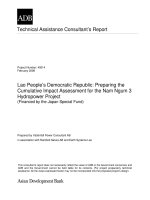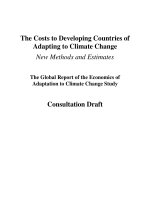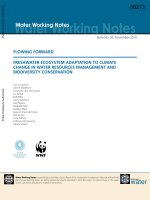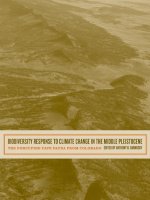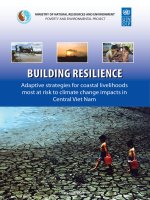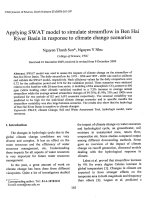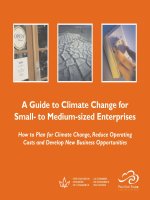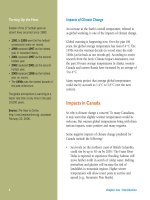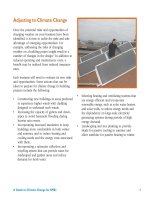UNEP vulnerability + impact assessment for adaptation to climate change training manual 2 (2009)
Bạn đang xem bản rút gọn của tài liệu. Xem và tải ngay bản đầy đủ của tài liệu tại đây (2.04 MB, 68 trang )
The GEO Approach to Integrated Environmental Assessment
VIA Module
List of contents
Definition of key terms
iv
List of Acronyms
vi
Overview
vii
Course Materials
Introduction and Learning Objectives
Relevance
1
1
3
1. Characteristics of Vulnerability and Scope of the Assessment
7
1.1
Defining vulnerability
7
1.2
Vulnerability to climate change
8
2. Vulnerability Assessments and the DPSIR Framework
12
3. Monitoring Vulnerability
16
4. Impacts of Climate Change and their Assessment
19
5. Creating Responses: Determining the adaptation options
28
5.1
Mainstreaming climate change into development decisions
28
5.2
Developing adaptation responses
30
6. Prioritizing Adaptation Responses
35
7. Developing a Basic Implementation Plan and a Communication Strategy
40
7.1
Implementing adaptation responses
40
7.2
Communicating climate change and adaptation
45
References
46
Appendix
49
A. Setting IEA in the context of existing UNFCCC processes
49
B. Facilitator’s preparation guide
50
C. Suggestions for integration of vulnerability, climate change and adaptation to
IEA process
54
D. Examples of the IEA Report Content with Included Vulnerability, Climate
Change and Adaptation s for Regional or Sub-National Reports
55
E. Sources of further information
57
IEA Training Manual
iii
VIA Module
An integrated environmental assessment and reporting training manual
Definition of Key Terms
Adaptation includes initiatives and measures to reduce the vulnerability of natural and human
systems against actual or expected stresses, including climate change effects. Various types of
adaptation exist, for example, anticipatory and reactive, private and public, and autonomous and
planned. Examples include: raising river or coastal dikes, the substitution of more temperatureshock resistant plants for sensitive ones, etc.
Adaptive capacity refers to the whole of capabilities, resources and institutions of a country or
region to implement effective adaptation measures.
An assessment is the entire social process for undertaking a critical objective evaluation and
analysis of data and information designed to meet user needs, and to support decision-making. It
applies the judgment of experts to existing knowledge to provide scientifically credible answers to
policy-relevant questions, quantifying, where possible, the level of confidence.
Climate change refers to a change in the state of the climate that can be identified (e.g., by using
statistical tests) by changes in the mean and/or the variability of its properties, and that persists for
an extended period, typically decades or longer. Climate change may be due to natural internal
processes or external forcings, or to persistent anthropogenic changes in the composition of the
atmosphere or in land use. Note that the United Nations Framework Convention on Climate Change
(UNFCCC), in Article 1, defines climate change as: “a change of climate which is attributed directly
or indirectly to human activity that alters the composition of the global atmosphere and which is
in addition to natural climate variability observed over comparable time periods.” The UNFCCC
thus makes a distinction between climate change attributable to human activities altering the
atmospheric composition, and climate variability attributable to natural causes.
Climate variability refers to variations in the mean state and other statistics (such as standard
deviations, the occurrence of extremes, etc.) of the climate on all spatial and temporal scales
beyond that of individual weather events. Variability may be due to natural internal processes
within the climate system (internal variability), or to variations in natural or anthropogenic external
forcing (external variability).
Development path or pathway is an evolution based on an array of technological, economic,
social, institutional, cultural and biophysical characteristics that determine the interactions
between natural and human systems, including production and consumption patterns in all
countries, over time at a particular scale. Alternative development paths refer to different possible
trajectories of development, the continuation of current trends being just one of the many paths.
Ecosystem is a dynamic complex of plant, animal and micro-organism communities and their
non-living environment, interacting as a functional unit.
Ecosystems-based adaptation refers to the management, conservation and restoration of
ecosystems creating a valuable yet under-utilized approach for climate change adaptation,
complementing other actions such as the development of infrastructure
Ecosystem services include the benefits people obtain from ecosystems (sometimes called
ecosystem goods and services). These include provisioning services, such as food and water;
regulating services, such as flood and disease control; cultural services, such as spiritual,
recreational and cultural benefits; and supporting services, such as nutrient cycling, that maintain
the conditions for life on Earth.
The Intergovernmental Panel on Climate Change (IPCC) is a scientific intergovernmental body
focused on evaluating the risk of climate change caused by human activity. The panel was
established in 1988 by the World Meteorological Organization (WMO) and the United Nations
Environment Programme (UNEP), two United Nations organizations. The IPCC shared the 2007
Nobel Peace Prize with former Vice President of the United States Al Gore.
iv
IEA Training Manual
The GEO Approach to Integrated Environmental Assessment
VIA Module
Kyoto Protocol to the United Nations Framework Convention on Climate Change (UNFCCC) was
adopted in 1997 in Kyoto, Japan, at the Third Session of the Conference of the Parties (COP) to the
UNFCCC. It contains legally binding commitments, in addition to those included in the UNFCCC.
Countries included in Annex B of the Protocol (most Organization for Economic Cooperation and
Development countries and countries with economies in transition) agreed to reduce their
anthropogenic greenhouse gas emissions (carbon dioxide, methane, nitrous oxide, hydrofluorocarbons,
perfluorocarbons and sulphur hexafluoride) by at least 5 per cent below 1990 levels in the 2008 to 2012
commitment period. The Kyoto Protocol entered into force on February 16, 2005.
Mainstreaming refers to the integration of adaptation objectives, strategies, policies, measures or
operations such that they become part of the national and regional development policies, processes
and budgets at all levels and stages.
Maladaptation refers to any changes in natural or human systems that inadvertently increase
vulnerability to climatic stimuli; an adaptation that does not succeed in reducing vulnerability but
increases it instead.
Mitigation refers to a technological change and substitution that reduce resource inputs and
emissions per unit of output. Although several social, economic and technological policies would
produce an emission reduction, with respect to climate change, mitigation means implementing
policies to reduce greenhouse gas emissions and enhance sinks.
Precautionary principle is a management concept stating that, in cases where there are threats of
serious or irreversible damage, lack of full scientific certainty shall not be used as a reason for
postponing cost-effective measures to prevent environmental degradation.
Resilience refers to the ability of a social or ecological system to absorb disturbances while
retaining the same basic structure and ways of functioning, the capacity for self-organization and
the capacity to adapt to stress and change. In the context of ecosystems, resilience refers to the level
of disturbance that an ecosystem can undergo without crossing a threshold into a different
structure or with different outputs. Resilience depends on ecological dynamics as well as human
organizational and institutional capacity to understand, manage and respond to these dynamics.
Scenario is a description of how the future may unfold based on “if-then” propositions, typically
consisting of a representation of an initial situation, a description of the key drivers and changes
that lead to a particular future state. For example, “given that we are on holiday at the coast, if it is
30 degrees tomorrow, we will go to the beach”.
Uncertainty implies anything from confidence just short of certainty to informed guesses or
speculations; it is important to recognize that even good data and thoughtful analysis may be
insufficient to dispel some aspects of uncertainty associated with the different standards of
evidence and degrees of risk aversion/acceptance that individuals participating in this debate may
hold. (WMO/TD No.1418, p.33)
United Nations Framework Convention on Climate Change (UNFCCC) was adopted on May 9,
1992 in New York and signed at the 1992 Earth Summit in Rio de Janeiro by more than 150 countries
and the European Community. Its ultimate objective is the stabilization of greenhouse gas
concentrations in the atmosphere at a level that would prevent dangerous anthropogenic interference
with the climate system. It contains commitments for all Parties. Under the Convention, Parties
included in Annex I (all OECD member countries in the year 1990 and countries with economies in
transition) aim to return greenhouse gas emissions not controlled by the Montreal Protocol to 1990
levels by the year 2000. The Convention entered in force in March 1994. See Kyoto Protocol.
Vulnerability is the degree to which a system is susceptible to, and unable to cope with, adverse
effects of climate change, including climate variability and extremes. Vulnerability is a function of
the character, magnitude and rate of climate change and variation to which a system is exposed, its
sensitivity, and its adaptive capacity.
Sources: IEA Training Manual Module no 1, IPCC, 2007; Halle et al., 2009, UN/ISDR 2004, UNDP 2006, UNEP 2007.
IEA Training Manual
v
VIA Module
An integrated environmental assessment and reporting training manual
List of Acronyms
vi
ASEAN
Association of Southeast Asian Nations
CCE
Climate Change Explorer
CIAT
International Center for Tropical Agriculture
DPSIR
Drivers, Pressures, State, Impacts, Responses
ECCO
Environment and Climate Change Outlook
EEA
The European Environmental Agency
EIA
Environmental Impact Assessment
GEO
Global Environmental Outlook
GCM
Global Circulation Model
GPS
Global Positioning System
GHG
Greenhouse Gas
IEA
Integrated Environmental Assessment
IED
The Institute of Economic Development
IIED
International Institute for Environment and Development
IISD
International Institute for Sustainable Development
IPCC
The Intergovernmental Panel on Climate Change
LDC
Least Developed Country
NAPA
National Adaptation Programs of Action
NEPAD
New Partnership for Africa’s Development
NGO
Non-governmental Organization
OECD
Organization for Economic Cooperation and Development
PRSP
Poverty Reduction Strategy
RCM
Regional Climate Models
SRES
Special Report on Emission Scenarios
UN/ISDR
United Nations International Strategy for Disaster Reduction
UNDP
United Nations Development Programme
UNEP
United Nations Environment Programme
UNITAR
United Nations Institute For Training and Research
UNFCCC
United Nations Framework Convention on Climate Change
IEA Training Manual
The GEO Approach to Integrated Environmental Assessment
VIA Module
Overview
Impacts of climate change pose very serious risks for countries, vital ecosystems, and sectors
including agriculture, forestry, health, local economic activities and biodiversity. In conjunction
with other pressures, they could also exacerbate other serious local and regional challenges, such as
poverty, poor healthcare, inequitable distribution of resources, diminishing ecological resiliency
and energy insecurity. This module will help you identify impacts of changing climate and
developing adaptive responses. It aims to help carry out a vulnerability and impact assessment
based on an ecosystem analysis and suggest sectoral adaptation options that are relevant to the
decision-makers. The adaptation options could be developed into practical implementation plans
at the sub-ministerial level. The module builds on the IEA conceptual framework and analytic
methods by providing guidance for their application to the case of climate change while preserving
the integrated approach.
Supported by examples and exercises, the module describes the process for addressing climate
change in the context of other development priorities and ecosystems to help decision-makers
move towards more sustainable development pathways and ecosystem resilience. In this module,
we emphasize that, when developing responses to climate change, the following key principles need
to be taken into account (Bizikova, et al., in press):
■ First, since maintaining healthy and resilient ecosystems, achieving development
priorities and improving the quality of life are as important as adaptation to climate
change, it is the combination of promoting conservation and restoration of ecosystems,
development choices, adaptation actions and capacities that will allow us to effectively
address the climate change.
■ Second, understanding the linkages between the impacts of a changing climate and
their implications at the local level is more complex than is captured in spatial, regional
and global climate models. Participation of local partners is necessary to facilitate
integration of climate impact information with local development knowledge to create
pathways that promote resilience and adaptation to climate change.
■ Third, understanding adaptation as part of ecosystem management and development
requires balancing the focus of the biophysical risks associated with climate change with
specific risks and opportunities in order to address issues such as ecosystem and human
well-being, capacity and long-term development.
This module outlines key approaches to help in assessing vulnerability to climate change in the
context of other non-climatic issues and stresses such as environmental change and consumption
levels, and their integration with other drivers and pressures. In this way, they make use of the
general DPSIR framework. The DPSIR framework also helps in mainstreaming responses to
climate change with other development measures.
IEA Training Manual
vii
VIA Module
An integrated environmental assessment and reporting training manual
This module is structured according to the following logic:
Overview of the course materials
Introduction and learning objectives
Relevance
Characteristics of vulnerability and scope of the assessment
Defining vulnerability
Specifying vulnerability to climate change
Vulnerability assessment and the DPSIR framework
Monitoring vulnerability
Impacts of climate change and their assessment
Creating responses – determining the adaptation options
Mainstreaming climate change into development decisions
Developing adaptation responses
Prioritizing adaptation responses
Developing a basic implementation plan and a communication strategy
Implementing adaptation responses
Communicating climate change and adaptation
viii
IEA Training Manual
The GEO Approach to Integrated Environmental Assessment
VIA Module
Course Materials
Introduction and learning objectives
Climate change impacts will affect social and ecological systems in complex and broad-ranging
ways as technological, economic, social and ecological changes take place across regions, groups
and sectors. Many of these impacts, such as impacts on ecological systems, have cascading effects
on social, economic and health outcomes. In order to respond to climate change, more vigorous
actions are required to mitigate emissions of greenhouse gases (GHGs) and to adapt to
unavoidable consequences that are increasing vulnerability around the world.
This module has been specifically developed to include adaptation issues into the Integrated
Environment Assessment (IEA) process. The IEA process is part of a mandate requiring that
countries regularly monitor their State of the Environment. Traditionally, these have been
developed in national, sub-regional and Global Environment Outlooks (please refer to Module 1
of the IEA training manual for more background).1 This module provides training on how to
include vulnerability, climate change and adaptation in the IEA process.2 When focusing on
impacts of climate change and developing adaptation responses, we can either be broad or focus
on target-specific themes such as agriculture, water resource management and coastal
development.
3
The DPSIR framework underlines the IEA process. It is explained in detail in Module 5 and refers
to Drivers (D), Pressures (P), State and trends (S), Impacts (I) and Responses (R). For this module,
a “current” DPSIR will be developed in which the responses (R) will focus only on capacities to
cope or to adapt (vulnerability assessment). A future DPSI will be developed (impact assessment)
in which the R will focus only on needed capacities. These will then be analyzed along side
proposed Responses in the form of adaptation options. It is suggested that the assessments are
ecosystem-based and the adaptation options are sectoral-based in an attempt to make science
policy relevant.
This module places local sustainability, its development challenges and local vulnerabilities in the
context of climate changes at regional and global levels in order to understand their linkages. It is
well recognized that a response strategy to climate change is an additional and new area of
sustainable community development, that in addition to many other local priorities like reducing
poverty, improving sanitation and safe access to fresh water, health issues and diminishing
ecological resiliency.
Accordingly, there is a need to explore linkages between climate change and development priorities
and identify those overarching sustainable development pathways that combine building resilient
communities and promoting adaptation to climate change.
1 The IEA Training Manual (UNEP and IISD, 2007) is a very important support resource for this module. It contains
eight modules: (1) The GEO Approach to Integrated Environmental Assessment; (2) National IEA Process Design
and Organization; (3) Developing an Impact Strategy for your IEA; (4) Monitoring, Data and Indicators; (5)
Integrated Analysis of Environmental Trends and Policies; (6) Scenario Development and Analysis; (7) Creating
Communication Outputs from the Assessment; (8) Monitoring, Evaluation and Increased Impact of the IEA
Process. Although several modules are not discussed in detail (Modules 2-6; Module 8), all are relevant to this
training module.
2 Specific methods of integration are listed in the Appendix.
IEA Training Manual
1
VIA Module
An integrated environmental assessment and reporting training manual
This module follows seven key steps:
1. Identifying characteristics of vulnerability and scope of the assessment
2. Assessing vulnerability and the DPSIR framework
3. Monitoring vulnerability
4. Identifying the impacts of climate change and their assessment
5. Creating responses and determining the adaptation options
6. Prioritizing the adaptation options
7. Developing a basic implementation plan and a communication strategy
In order to illustrate the concepts and methodologies introduced in the steps of this module, a
number of case studies focusing on vulnerability, identification of adaptation options,
prioritization and implementation are presented. To help the facilitators through the training
event, we also included guidance on the key stakeholders and materials needed for the training.
Upon successful completion of this module, the user will be prepared to integrate climate change
and vulnerability into IEA. Specifically, they will be able to:
■ Conduct and interpret vulnerability assessments by understanding its key components
of exposure, sensitivity and capacity;
■ Identify impacts of future climate change and climate variability on human well-being
and environment
■ Identify key areas of integration, in which adaptation to climate change goes hand-inhand with other development priorities and building resilience in natural and human
systems;
■ Identify and develop basic elements of an implementation plan to progress with
adaptation options.
Building on the generic IEA framework, the following are key questions to be answered through
integrated climate change and vulnerability assessments for adaptation in the local, regional and
national context:
1. What are the key exposures and sensitivities leading to vulnerability and how effective
are the applied coping strategies?
2. What are the key consequences of climate change impacts on the environment and
human well-being?
3. What are the adaptation responses that could address the estimated impacts of climate
change while helping build resilience in natural and human systems?
4. What are the types of policies, capacities and main steps needed to be undertaken to
implementation adaptations?
2
IEA Training Manual
The GEO Approach to Integrated Environmental Assessment
VIA Module
Relevance
Climate change: Impacts and vulnerabilities that
the Earth system faces
Climate change is a reality. It is considered the biggest environmental threat in human history and
the defining human challenge for the twenty-first century (IPCC, 2007; UNDP, 2007).
Consequences of climate change are already felt throughout the Earth system. The effects of
climate change are observed on every continent and in all sectors. However, adaptation to these
changes needs to not only respond to these impacts, but also needs to be integrated into sustainable
development strategies and their implementation.
Box 1: Defining climate change
6
The Earth’s climate is a complex system consisting of the atmosphere, land surface, snow
and ice, oceans and other bodies of water, and living things. The atmospheric component
of the climate system most obviously characterizes climate; climate is usually defined as
“average weather,” described in terms of the mean and variability of temperature,
precipitation and wind over a period of time, ranging from months to millions of years (the
typical period is 30 years).
Projecting changes in climate systems is different from a weather forecasting and is
indeed a much more manageable issue. Based on the foundation of current climate
models, there is considerable confidence that climate models provide credible quantitative
estimates of future climate change. However, to be able to predict changing climate, the
results will not only depend on the interaction among characteristics of the climate, but
also on the amount of greenhouse gasses (GHGs) released into the atmosphere. The
amount of GHGs in the atmosphere is determined by released gases both from human
and natural sources and by their removal through sinks, which mainly include
photosynthesis in vegetation. Furthermore, the climate reacts over long periods to
influences upon it; many GHGs remain in the atmosphere for thousands of years.
Source: IPCC, 2007; UNEP, 2009
IEA Training Manual
3
VIA Module
An integrated environmental assessment and reporting training manual
Figure 1: Atmospheric concentrations of important long-lived GHGs over the last 2,000 years. Increases
since about 1750 are attributed to human activities in the industrial era. Concentration units are parts per million
(ppm) or parts per billion (ppb), indicating the number of molecules of the GHG per million or billion air molecules,
respectively, in an atmospheric sample.
Concentrations of greenhouse gases from 0 to 2005
400
2000
Carbon dioxide (CO2)
Methane (CH4)
1800
Nitrous oxide (N2O)
1400
CH4 (ppb)
6
CO2 (ppm), N2O (ppb)
1600
350
1200
300
1000
800
250
600
0
500
1000
1500
2000
Year
We are already committed to changes based on past emissions of GHGs into the atmosphere, and
it is the future that is being decided. Some of the observed changes include (UNEP, 2009):
■ Of the last 12 years (1995–2006), 11 are among the 12 warmest since records began in
1850. The temperature increase is widespread across the world but is most marked in
the northern polar regions.
■ Sea levels across the globe have risen in a way consistent with the warming. The total
global rise in the twentieth century amounted to 17 centimetres.
■ Satellite data recorded since 1978 show the annual average Arctic sea ice extent has
shrunk by 2.7 per cent each decade, with larger decreases in summer. Mountain glaciers
and average snow cover have declined in both hemispheres.
■ From 1900 to 2005, precipitation (rain, sleet and snow) increased significantly in parts
of the Americas, northern Europe and northern and central Asia resulting in floods, but
declined in the Sahel, the Mediterranean, southern Africa and parts of southern Asia,
causing serious droughts. Furthermore, floods and cyclones have occurred more
frequently in the last 30 years, while other disasters not influenced by climate (such as
earthquakes) are constant over decades. However, a lack of systematic high quality
observation before satellite observations makes it difficult to detect a long-term trend
(Figure 2).
4
IEA Training Manual
VIA Module
The GEO Approach to Integrated Environmental Assessment
Figure 2: Trends in number of reported disasters
Eathquakes versus climatic disasters
250
Floods
Earthquakes
Cyclones
200
150
11
100
50
0
1980
1985
1990
1995
2000
2005
2010
Source: UNEP, 2008
When identifying impacts of global changes, including climate change, we are concerned about
changes happening at a fast pace that would make it impossible for humans and ecosystems to
adapt. Although Earth’s complex systems sometimes respond smoothly to changing pressures, it
seems that this will prove to be the exception rather than the rule. Many subsystems of Earth react
in a nonlinear, often abrupt, way, and are particularly sensitive around threshold levels of certain
key variables. If these thresholds are crossed, then important subsystems, such as a monsoon
system, could shift into a new state, often with deleterious or potentially even disastrous
consequences for humans (Rockström, et al., 2009).
Critical elements of climate change impacts include the possibility of sudden changes linked to
thresholds or tipping points, especially for vulnerable complex systems; a tiny perturbation can
qualitatively alter the state or development of a system, leading to large and widespread
consequences. Examples of such changes include climate impacts, such as those arising from ice
sheet disintegration and leading to large sea-level rises or changes to the carbon cycle, or those
affecting natural and managed ecosystems, infrastructure and tourism in the Arctic (Schneider, et
al., 2007).
IEA Training Manual
5
VIA Module
An integrated environmental assessment and reporting training manual
When we are looking into the future, a wide range of impacts attributed to climate change are
projected. Even if GHG and aerosol concentrations were kept constant at 2000’s levels, some
anthropogenic warming and rise in sea level would continue for many centuries. Backed up by new
studies and observations, the IPCC projects the following regional-scale changes (UNEP, 2009):
■ most warming will happen over land and at the highest northern latitudes, and least
over the Southern Ocean and parts of the North Atlantic;
■ contraction of the area covered by snow will also lead to an increase in the depth at
which most permafrost will thaw and to a decrease in the extent of sea ice;
■ increase in the frequency of extremes of heat, heat waves and heavy precipitation; and
■ a likely increase in tropical cyclone intensity.
We can reduce these impacts and minimize their consequences by mitigating emissions of GHGs
and also by adapting to unavoidable consequences. There is no single solution. Adaptation should
not only be seen as a reaction to the changing climate but rather as an opportunity to improve
human and ecosystem well-being and build resilience. Implementing environmentally sound
adaptation options should lead to measurably reduced vulnerability, improved resilience to future
changes and higher potential for well-being.
6
IEA Training Manual
The GEO Approach to Integrated Environmental Assessment
VIA Module
1. Characteristics of vulnerability and scope of the assessment
2. Vulnerability assessment and the DPSIR framework
3. Monitoring vulnerability
4. Impacts of climate change and their assessment
5. Creating responses: Determining the adaptation options
6. Prioritizing adaptation responses
7. Developing a basic implementation plan and a communication strategy
1. Characteristics of Vulnerability and Scope of
the Assessment
1.1 Defining vulnerability
People and communities are experiencing a number of threats, such as climate change and
environmental degradation, social and economic changes. These changes do not occur in isolation
and often reflect changes in the global markets that may amplify or dampen the importance of the
environmental challenges. Vulnerability refers to the potential of a system to be harmed by an
external stress (for instance a threat). It is defined as a function of exposure, sensitivity to impacts
and the ability or lack of ability to cope or adapt. The exposure can be to hazards such as drought,
conflict or extreme price fluctuations, and also underlying socio-economic, institutional and
environmental conditions. The severity of the impacts not only depend on the exposure, but also
on the sensitivity of the specific unit exposed (such as an ecosystem, a watershed, an island, a
household, a village, a city or a country) and on the capacity to cope or adapt. The concept of
vulnerability is an important extension of traditional risk analysis, which focused primarily on
natural hazards (Turner et al., 2003; Schneider, et al., 2007; Jäger and Kok, 2008; Leichenko and
O’Brien, 2002). This concept has also undergone a shift from research-based activities to a
stakeholder-driven approach that can be anchored in the past and present (vulnerability
assessments) and provide responses bearing in mind potential future scenarios (impact
assessments; see Box 4).
18
Box 2: Overview of the
development of vulnerability assessments
Vulnerability assessments focused on climate change impacts and adaptation are the
product of three streams of research. The first two traditions, impact assessments and
risk/hazards research, generally focus on the multiple effects of a single stress. Impact
assessments would, for example, examine if building a hydropower station could impact
local communities, habitat and biodiversity. Risk and hazard assessment could include
potential emergency events, such as floods and earthquakes. A third type of assessment
is focused on the multiple causes of a single effect; for example, food security studies
generally focused on hunger or famine. Such studies see hunger as the consequence of
a number of stresses and issues such as drought, political marginalization, inequality,
global market changes, land degradation and other environmental stresses.
The emerging field of currently-conducted vulnerability assessments draws heavily from
these three streams. Thus, the novelty is not so much the development of new conceptual
domains, but the integration across these three traditions.
Source: Schroter, et al., 2005 (modified)
IEA Training Manual
7
VIA Module
An integrated environmental assessment and reporting training manual
1.2 Vulnerability to climate change
When focusing on climate change, vulnerability could be described as the degree to which a system
is susceptible to, or unable to cope with, the adverse effects of climate change, including climate
variability and extremes (Figure 3). The term vulnerability may therefore refer to the people and
communities living in a specific system, including the vulnerable system itself (e.g., low-lying
islands or coastal cities); the impacts of this system (e.g., flooding of coastal cities and agricultural
lands or forced migration); or the mechanism causing these impacts (e.g., disintegration of the
West Antarctic ice sheet) (UNEP, 2009).
Figure 3: Components of vulnerability to climate change
Exposure
Sensitivity
Potential
impacts
Adaptive
capacity
Vulnerability
Adaptation responses
Source: Allen Consulting, 2005 (modified)
20
In the context of climate change, vulnerability is a function of the character, magnitude and rate of
climate variation to which a system is exposed, people’s sensitivity and their adaptive capacity.
Exposure could include geographical location, especially related to high exposure to risks (i.e.,
people living in the areas of natural disasters such as drought or coastal areas and river basins
affected by floods).
Sensitivity and adaptive capacity are context-specific and vary from country to country, from
community to community, among social groups and individuals, and over time in terms of its
value, but also according to its nature. A population could be considered sensitive based on their
overall level of social development (i.e., a population containing people sick with malaria,
HIV/AIDS, areas with rain-fed agriculture, limited access to resources for migrants, widows,
disabled people with higher level of poverty and food insecurity). Finally, adaptive capacity
depends on access to resources that could help in responding to threats and exposures (i.e.,
functioning community networks, access to low-rate loans, accessible services such as health care
and sanitation, irrigation systems and water storage, etc.).This includes the ability of individuals to
cooperate within households, but also with neighbors and with the community leaders and their
involvement in decision-making. Adaptive capacity of the communities is often depleted when
they are in conflict zones, when they forced to migrate and in areas with low law enforcement.
8
IEA Training Manual
The GEO Approach to Integrated Environmental Assessment
VIA Module
Box 3: Examples of human health vulnerabilities
in the context of climate change
Exposure
Impacts on human well-being
and environment
Sensitivities, limited capacities
and pressures contributing to
the impacts
- More frequent
geographically
widespread and
sustained
epidemics of
infectious and
waterborne
disease with
high human
mortality
- Geographically widespread
changes in climate that
increase the geographic
area and number of disease
vectors
- More frequent heavy rainfall
and drought events that
disrupt water supply and
sanitation and expose people
to waterborne pathogens
- Severely degraded or
collapsed health care system
- Poor and declining immunity,
nutritional and health status of
large portion of population
- High poverty rates that limit
access to health care
- Lack of disease surveillance,
vector control and prevention
programs
- Large portion of population
lose reliable access to
potable water and sanitation
- Land use changes, including
new reservoirs that increase
habitat for disease vectors
- Emergence of
new or more
virulent strains of
infectious disease
- More frequent but
geographicallyand temporallylimited epidemics
with high or
moderate mortality
- Increase in number
of infectious disease
cases and mortality
in endemic areas
and seasons
- Changes in disease and
vector ecology and
transmission pathways
altered by changing
climate
- Changes in climate that
moderately increase
exposures by expanding
endemic areas and seasons
- Land use changes that
increase habitat for disease
vectors
- Crowding
- Drug resistance
- International migration, travel
and trade
- Water storage and sanitation
practices
- Poor programs for disease
surveillance, vector control
and disease prevention
- Declining quality and increasing
cost of health care
- More frequent but
geographically and
temporally limited
epidemics that are
not life threatening
with no mortality
- Altered disease and vector
ecology and transmission
pathways
- Moderate increase
exposures by expanding
endemic areas and seasons
- Limited access to health care
- Lacking effective disease
surveillance, vector control
and disease prevention
- Malnutrition
- Limited access to potable
water and sanitation
22
Source: Leary and Kulkarni, 2007 (selected)
IEA Training Manual
9
VIA Module
An integrated environmental assessment and reporting training manual
Finally, there is a very strong relationship between exposure to climate impacts and adaptive
capacities and overall ecosystem degradation. Specifically, climate change exacerbates ecosystem
degradation (i.e., land-cover change, over-exploitation, pollution) causing substantial changes in
ecosystems structure and function so they are no longer able to provide ecosystems services such
as fresh water, coastal flood protection and erosion control. On the other hand, ecosystem
degradation often triggers more disasters and reduces nature’s and people’s capacities to withstand
impacts of climate change and disasters because degradation is limiting ecosystems, abilities to
provide buffers against floods, heavy rain and sea-level rise (UNEP, 2009).
Box 4. Exposures and sensitivities
leading to vulnerability in West Africa
Throughout West Africa, agriculture is the mainstay of the economy. Over 74 per cent of
the region’s poor are involved in agricultural production, and exports of agricultural
products are the dominant source of foreign exchange. While agriculture is the main
livelihood source for most poor people, it is typically supplemented by other activities,
such as seasonal and urban migration, handicrafts and small scale trading.
Of all the exposures, drought commonly receives the most attention. First, because the
agricultural production is mostly rain-fed, it is very sensitive to repeated exposure to
drought. This also includes vulnerability of population, as alternative sources of income
could not cover the reduction in production so drought led to widespread famines and
periods of hunger and nutritional stress. Because the poor generally rely on agriculture for
a major part of their income, drought has significant direct impacts, but by reducing
access to water, it also has indirect, but significant, impacts on the health of people and
local ecosystems. In addition to drought, hail, lightning and tornados are pervasive threats
to agricultural productivity and livelihoods throughout the region.
People are better able to cope when they use terraces to control soil erosion and smallscale water collection systems; or in diversifying their income sources, perhaps by
purchasing tools for a specific job, like construction. Such investments also help reduce
vulnerability and improve overall livelihood security. Finally, in terms of actual sensitivity and
extent of vulnerability, substantial differences exist among the poor as a population and
more differences appear when comparing farming systems, urban and rural livelihoods,
gender, households or household members.
Source: Dow, 2005
We may regard vulnerable people and communities as victims of environmental degradation, volatile
markets, climate change and other risks; however, it is becoming apparent that many vulnerable
communities have the capacities to anticipate and cope with these risks. For example, in flood-prone
areas, many communities use housing construction materials that could be easily dissembled or
moved. However, if the flooding is too frequent, too severe or occurs during the major cropping
seasons, and communities are less able to obtain key crops, meaning that their capacities could be
exceeded and they could suffer serious consequences. These consequences are also influenced by
overall ecosystem health and, very likely, in areas with degraded ecosystems they are also less able to
provide a buffer for the communities against flooding. The concept of resilience has been used to
characterize a system’s ability to bounce back to a reference state after a disturbance, and the capacity
of a system to maintain certain structures and functions despite disturbance. If the resilience is
exceeded, collapse can occur (Gunderson and Holling, 2002; Jäger and Kok, 2008; UNEP 2009).
Therefore, the focus of the vulnerability reduction efforts should be on helping to increase resilience
both for people and ecosystems, instead of only reacting to actual impacts.
10
IEA Training Manual
The GEO Approach to Integrated Environmental Assessment
VIA Module
Defining the scope of the assessment3
26
In principle, you can carry out an IEA assessment that includes vulnerability and climate change
impact assessments for any given issue, geographic area or level of decision-making. In practice
however, there usually are two choices: analysis based on jurisdictional (political) boundaries, or
on non-political boundaries (e.g., ecoregion, watershed). Using either approach has advantages
and disadvantages; only rarely do the two spatial boundaries coincide, as they do, for example, in
small island states. In practice, assessments are often focused on a country, but even in this case,
there is a need to analyze specific issues on the level of ecological units (e.g., ecosystems, watershed,
airsheds), usually both in sub-national and transboundary contexts.
In a more traditional approach, the analysis is organized around environmental themes (e.g., water,
air). From the perspective of policy, however, environmental problems under different themes
often intersect with the same set of socio-economic processes or policies. Development of the
transportation infrastructure, for instance, has implications for land cover, water quality and
biodiversity. Such impacts would appear fragmented if the analysis were structured around
environmental themes. So, from one point of view, analyzing environmental implications of the
sector would be more practical/strategic.
However, using a sectoral approach, for example, transport, energy, agriculture, may result in
fragmenting the environmental picture. Pressures on water quality, for example, may need to be
addressed under agriculture, energy and municipal water supply.
Although we have presented sectoral and thematic approaches as two distinctly different
alternatives in this module, there are ways to combine the two, depending on the environmental
problems and information needs of your country or region. Before starting an actual assessment,
your core group should have analyzed its assessment needs, and agreed on a clear set of the
objectives and goals for the process.
EXERCISE 1
1. What were the contexts of previous State of the Environment reporting processes in
your country?
2. Having considered the contexts of previous reporting processes and the existing and
environmental and climate change information needs for decision-making, what is the
best context for assessment process in your country?
28
3. How might the new assessment process and report be designed to sufficiently address
transboundary environmental issues and problems?
For further details on stakeholder involvement see IEA Modules 3 and 5
3 Source, and for details, see Module 5
IEA Training Manual
11
VIA Module
An integrated environmental assessment and reporting training manual
1. Characteristics of vulnerability and scope of the assessment
2. Vulnerability assessment and the DPSIR framework
3. Monitoring vulnerability
4. Impacts of climate change and their assessment
5. Creating responses: Determining the adaptation options
6. Prioritizing adaptation responses
7. Developing a basic implementation plan and a communication strategy
2. Vulnerability Assessments and the DPSIR
Framework
Please refer back to Module 5 of the IEA training manual for this section
The point of departure for vulnerability assessments and interventions lies in the question,
‘‘Vulnerable to what?’’ When answering this question, attention should be paid to trying to
investigate the singular or most important cause of vulnerability, identifying where and how
different drivers and pressures interact and lead to vulnerability, and the available capacities to
cope with threats. This exercise shows that processes such as epidemics or environmental changes,
including climate change, are not occurring in isolation of one another, or in isolation of other
drivers and pressures, including those linked to economic globalization (Leichenko and O’Brien,
2002). A community that switches to planting cash crops and whose market prices are dropping
will have fewer resources to cope with severe climatic events, which could include droughts, floods
or cyclones. Similarly, communities that are heavily in debt may not allocate enough resources to
maintain early warning systems, regular inspections of dykes or upgrade dykes. They are more
susceptible to potential impacts of climatic events than a well-prepared community. When
assessing vulnerability, we should take into account that vulnerability can vary considerably
between countries or regions, but even among members of the same community. Furthermore,
vulnerability is a dynamic concept, and stressors on the human-environment system are constantly
changing, as are the available capacities over time.
31
Vulnerability assessment suitably identifies areas of unsustainability, specific capacities and
potential responses of vulnerable people in the context of exposure in particular locations, but it is
challenging to take into account whole system perspectives, with driving forces and pressures often
operating on a national or even global scale. DPSIR is a framework applied in GEO reports,
including the fifth Global Environment Outlook: Environment for Development (GEO-5), that seeks
to connect causes (drivers and pressures) to environmental outcomes (state and impacts),
including impacts of changing climate, and to activities that shape the environment (policies,
responses and decisions), including both adaptation and mitigation responses to climate change.
Integrating principles of vulnerability assessment with available information on current and future
climate change into the DPSIR framework helps to develop adaptation responses that are relevant
to other socio-economic and environmental challenges. An opportunity to better understand the
impacts of environmental change on human systems is provided by the vulnerability approach
(Kok and Jaeger, 2007; see Figure 4).
As an IEA analytical framework, DPSIR entails analysis of the following components, which could
be done in three stages:
■ Stage 1: Drivers, Pressures, State and Trends
■ Stage 2: Impacts
■ Stage 3: Responses (for vulnerability assessment, only focusing on coping and adaptive
capacities)
12
IEA Training Manual
VIA Module
The GEO Approach to Integrated Environmental Assessment
We believe that there could be different ways of analyzing environment and areas using the DPSIR
framework and the climate change lens. Depending on the scale of the analyses, drivers and
pressures would change. Below are different examples of how the different elements of the DPSIR
could be identified. How the DPSIR is developed depends on the scale chosen for the analysis;
depending on the scale, the drivers and pressures would change.
Step 1: Drivers, Pressure, State and Trends
What is happening to the environment and why?
Step one of the DPSIR addresses the question of what is happening to the environment, why these
changes are happening and the trends associated therewith (see UNEP, 2007). The following are
simple climate change-related examples for the components in the first step:
■ Drivers (e.g., industrial activities, farming, landfill sites, consumption patterns)
■ Pressures (e.g., urbanization, changes in agricultural production, increased CO2
emissions)
■ State (and effects/trends) (e.g., more drought and/or flooding)
Figure 4: Linking DPSIR and vulnerability assessment
HUMAN SOCIETY
DRIVERS
PRESSURES
Direct influence
through human
interventions
Urbanization,
shifting to cash
crops, increasing
costs of health
care, increases
levels of GHGs
Soil infiltration,
stability, structure
Evapotranspiration
cycles
Natural processes
Indirect influence through
human development
Population growth, industrial
processes, energy
demands
IMPACTS
Human well-being
Step 1
RESPONSES
Crop losses, less water
for people, irrigation and
livestock, increased
number
of sick
Step 2
and mortality
of people and livestock,
famine, malnutrition
Step 3
Mitigation and
adaptation
Adapting by building dykes,
increasing irrigation, changing
planted species and mitigating
climate change by reducing
GHGs, increasing renewable
energy, energy efficiency
Economic,
social goods
and services
Wild products
wood
availability,
flood protection
capacity
Ecosystem
services
Changes in
vegetation,
fish and
migratory
bird
populations,
pest
outbreaks
33
STATE and TRENDS
Step 1
Water, land, atmosphere, biodiversity
Increased occurrence of cyclones,
drought, floods, changes in precipitation
patterns, increase occurrence of pests
Step 1
ENVIRONMENT
Understanding the vulnerability includes identifying to what extent the system is sensitive to
identified impacts in the context of available adaptive capacities. The following questions could
be used to investigate the available capacities and strategies:
• How often do the identified impacts, including disasters, hit the community? Is the
incidence growing?
• Based on the trends, drivers and pressures, what are the main causes of vulnerability?
• What coping strategies exist for each identified impact? How effective are these coping
strategies? What are the capacities that are lacking to address the identified impacts?
• Which organizations/institutions, if any, support existing coping strategies or promote new
strategies?
Source: Baas et al. (2008), modified
IEA Training Manual
13
VIA Module
An integrated environmental assessment and reporting training manual
Step 2: Impacts
What are the consequences for the environment and humanity?
Induced by the drivers and caused by pressures, the state of the environment (the physical, chemical
or biological components of the Earth systems, biosphere, basins, etc.) impacts the normal functioning
of ecosystems and the welfare of human beings. Environmental and other impacts are indeed
ecosystem-specific. Box 5 shows state/changes on the hydrological regime and their impacts on human
health, food security, human safety and socio-economic well-being on a global scale.
Box 5: Linkages between state changes in
the water environment and environmental
and human impacts
HUMAN WELL-BEING IMPACTS
State Changes Environmental/ Human Health
Ecosystem
Impacts
Food Security
Physical
Security and
Safety
Socioeconomic
Effect
CC – disturbances to the hydrological regime on the global scale
Sea surface
temperature
Precipitation
Trophic
structure
and food
web
Food safety
Fishery
species
distribution
Aquaculture
production
Profits (loss
of product
sales)
Coral
bleaching
Artisanal
fisheries
Coast
protection
Tourism
attraction
Sea-level
rise
Aquaculture
facilities
Coastal/
island
flooding
Damage to
property,
infrastructure
and
agriculture
Tropical
storm and
hurricane
frequency
and intensity
Disruption of
utility
services
Crop
damage
Aquaculture
damage
Drowning
and flood
damage
Coast
protection
Energy
production
Flood
damage
Water-related
diseases
Crop
destruction
Drowning
and flood
damage
Damage to
property
Drought
Malnutrition
Crop
reduction
Law and
order
Damage to
property and
infrastructure
Human water use-related issues: Disturbances to the hydrological regime at basin
and coastal scale
Stream flow
modification
Downstream
drinking water
Irrigated
agriculture
Water-borne
diseases
Island fish
stocks
Flood control
Community
displacement
Freshwater
fisheries
Salination
Floodplain
cultivation
Ecosystem
fragmentation,
welfare
infilling and
drainage
Artisanal
fisheries
Sediment
transport
to coasts
Aquaculture
facilities
Coastal
erosion
Reservoir
lifecycle
Source: Jäger and Kok, 2008
14
IEA Training Manual
The GEO Approach to Integrated Environmental Assessment
VIA Module
Step 3: Responses—for vulnerability assessment only (defining the existing capacities)
What is being done and how effective is it?
These responses are normally measures that need to be taken to address the impacts. These
responses need to be crafted to minimize the impact of the drivers and pressures on ecosystems
and maximize the welfare of human beings. It is important to distinguish between coping and
adaptation strategies. While, coping strategies undermine capacities of the people to respond to
future threats, adaptation actions aim to create proactive responses that help build future
capacities. We will focus on how to develop adaptation responses to climate change impacts in the
context of other development challenges, and the need to preserve ecosystems and build capacities
in the next chapters.
EXERCISE 2
Create groups of 3–4 persons. Based on the discussion from the previous exercise, indentify an
ecosystem or an area and complete the following tasks approximately within approximately fifteen
minutes, using flipchart paper to record key points. Please be prepared to discuss your key points
in plenary.
1. For the selected area/ecosystems, identify major exposures—current and past states and
trends (select one major exposure)—and identify the impacts of ecosystems, ecosystems
services and human well-being
36
2. On sticky notes, write down human and ecosystem sensitivities (e.g., low levels of
education, poverty, diseases, infrastructure located in sensitive areas, rain-fed
agriculture, ecosystem fragmentation, etc.), key drivers and pressures that contribute to
the identified exposures, sensitivities and coping responses and stick next to the impacts
written on the flipchart.
3. What are the main coping strategies and capacities that people use to respond to the
exposures to reduce impacts?
4. Review the identified sensitivities, impacts and coping strategies and formulate a
statement about what types of ecosystems and what groups of populations are most
vulnerable because of high sensitivity, impacts and lack of or ineffective coping
responses.
Focus: Area/Ecosystem
1. Exposures: current and past states and trends (for example drought, floods, heavy precipitation over
short-time, occurrence of disease)
2. Impacts on:
Ecosystems and ecosystem services
Human well-being
3. Examples of coping responses
Vulnerability of the area:
IEA Training Manual
15
VIA Module
An integrated environmental assessment and reporting training manual
1. Characteristics of vulnerability and scope of the assessment
2. Vulnerability assessment and the DPSIR framework
3. Monitoring vulnerability
4. Impacts of climate change and their assessment
5. Creating responses: Determining the adaptation options
6. Prioritizing adaptation responses
7. Developing a basic implementation plan and a communication strategy
3. Monitoring Vulnerability
An indicator is a single measure of a characteristic and an index is a composite measure of several
indicators or indices. Indicators and indices can be useful when guiding decision-making and
prioritizing intervention, as they allow for a comparison of characteristics (Downing and
Ziervogel, 2004). However, the vulnerability indicators must also account for the diverse socioeconomic and environmental situation within countries, regions and processes that shape
vulnerability and available capacities.
Indicator development often begins with a conceptual framework, followed by the selection of
indicators based on a criteria of suitability. Indicator development is often an iterative process,
where a large number of environmental, socio-economic or sustainable development issues are
narrowed down in successive rounds of dialogue with stakeholders and experts to a few high-level
measures. Figure 5 provides an example of the process used for indicator development in South
Africa (IEA, Module 4).
Vulnerability can be monitored by identifying indicators and by creating indices that could both
be presented spatially and non-spatially.
Figure 5: Example of an indicator development process from South Africa.
Application of
criteria
Step 1
Identification of
a framework to
guide the
selection of
draft indicators
39
Review of
legislation
Step 2
Selection of a
broad set of
draft indicators
Step 3
Categorization
of indicators into
the core set and
other associated
sets of indicators
Consultation with
key stakeholders
Source: IEA module 4
16
IEA Training Manual
The GEO Approach to Integrated Environmental Assessment
VIA Module
Examples of indicators that could be used to assess vulnerability:
Monitoring states, trends and exposure
■
■
■
■
41
Frequency of natural events (floods, droughts and cyclones)
Location and intensity of wild fires
Number of consecutive days with precipitation/temperatures exceeding certain levels
Number of frost days
Monitoring impacts and sensitivity
■ Population affected by natural disasters (number of people affected by floods/
droughts/cyclones per event, per year/period
■ Infrastructure (lengths and types of road located on coasts being damaged by floods/
cyclones in areas and per year/period)
■ Land use (changes in areas of forests/pastures/agricultural land, coastal areas)
■ Assets, land value, types of houses
■ Household size and types (female-headed households)
■ Role of sensitive sectors (employment and revenues from sector such as agriculture,
fisheries and tourism)
■ Food sufficiency (amount of available food storage over time)
■ Major crop types (production and losses)
■ Areas of rain-fed agriculture, irrigation rate, irrigation source
■ Percentage of households below poverty
■ Level of education or literacy
■ Diseases and health care delivery (number of people suffering from diseases, access to
health care—hospitals, mobile clinics by area)
Examples of indexes:
■
■
■
■
Human development index
Social vulnerability index
Environmental vulnerability index
Coastal risk index
Figure 6: Spatially represented indicators for Honduras, a population at the risk of flooding and
landslides.
Source: Winograd, n.d.
IEA Training Manual
17
